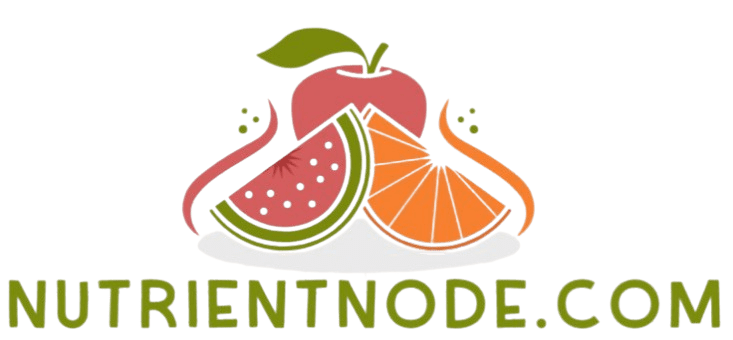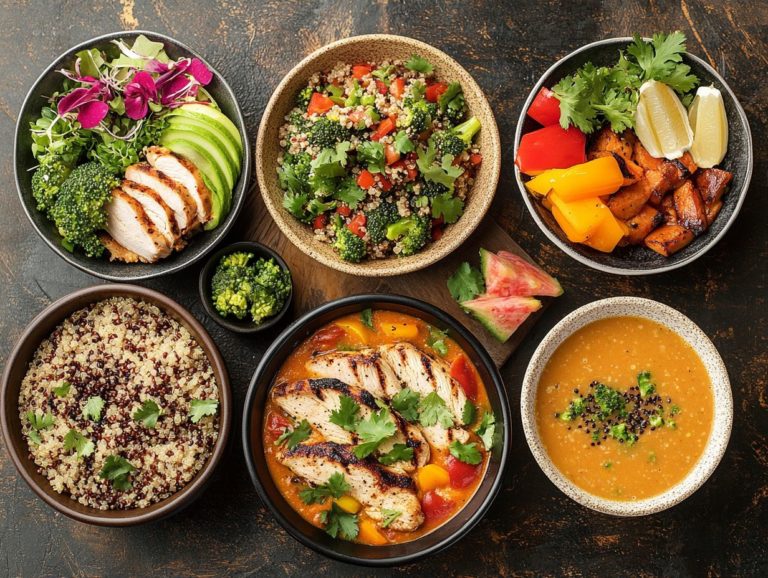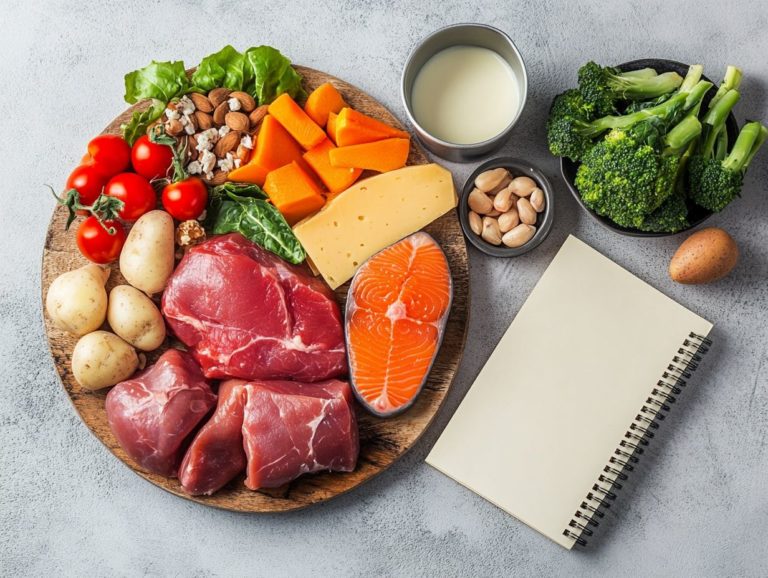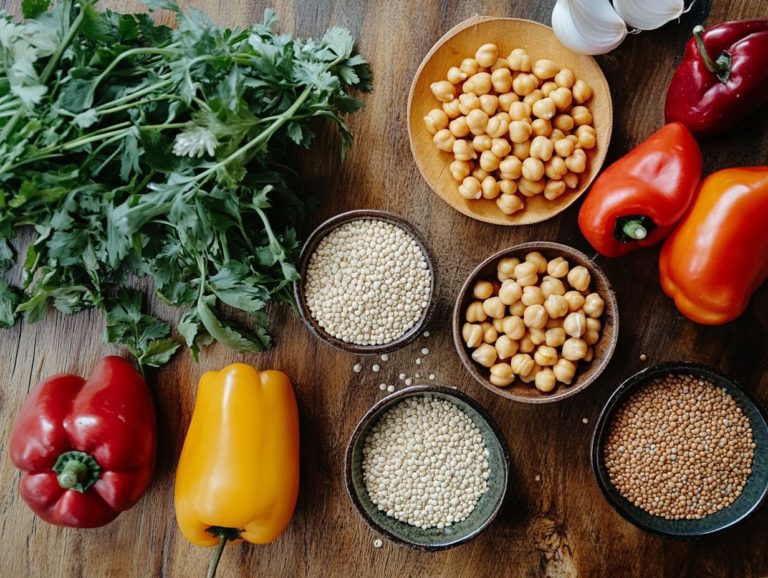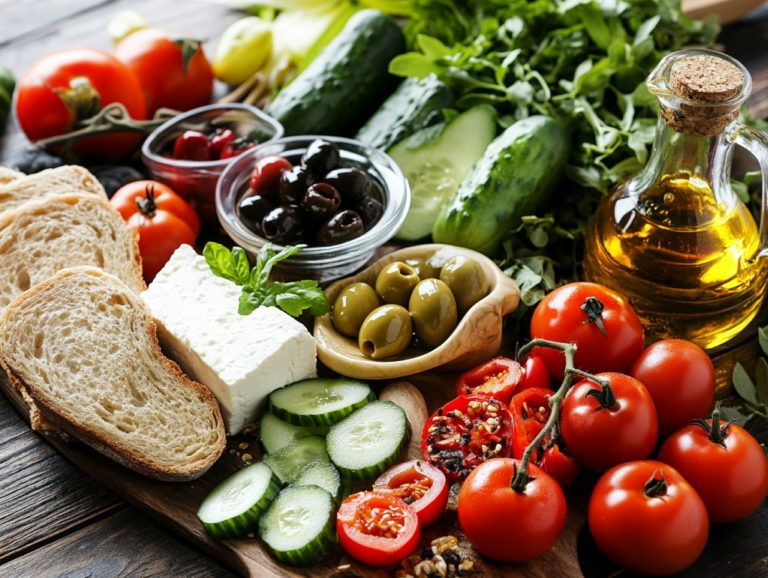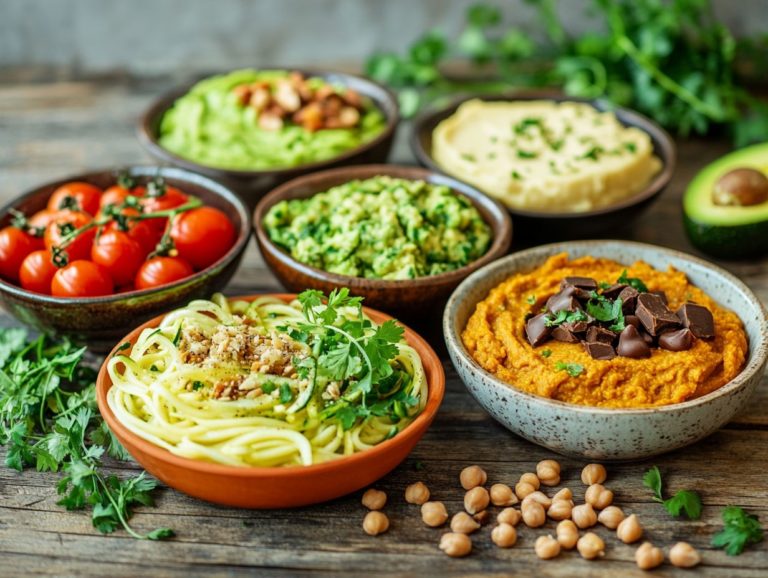Understanding the Paleo Diet: A Comprehensive Guide
The Paleo Diet has surged in popularity, celebrated as a natural approach to nutrition that reflects the eating habits of our ancient ancestors.
This overview delves into the fundamental principles of the Paleo Diet, highlighting its physical and mental health benefits. It offers practical tips for meal planning and grocery shopping while addressing common misconceptions, outlining potential risks, and providing strategies for seamlessly integrating exercise into a Paleo lifestyle.
Whether you re a devoted enthusiast or simply exploring your options, this guide will empower you with the insights needed to navigate the world of Paleo with confidence.
Contents
Key Takeaways:

The Paleo Diet is based on the principle of eating whole, unprocessed foods that our ancestors ate. Adopting the Paleo Diet can lead to improved physical and mental health and help manage certain health conditions. Incorporating exercise into the Paleo lifestyle can further enhance health benefits and provide a well-rounded approach to overall wellness.
What is the Paleo Diet?
The Paleo diet, inspired by the dietary habits of our ancestors during the Paleolithic Era, encourages you to adopt a way of eating centered around whole, unprocessed foods that meet your body’s nutritional needs.
By prioritizing fresh fruits, vegetables, lean meats, fish, eggs, nuts, and seeds, the Paleo approach encourages you to eliminate processed foods and grains that have infiltrated the modern diet. This ultimately fosters a healthier, more fulfilling way of eating.
Overview of the Diet and its Principles
The principles of the Paleo diet center around embracing food groups that reflect our ancestral eating habits and focus on options that meet your nutritional needs.
This diet empowers you to prioritize whole foods, encompassing a rich variety of fruits, vegetables, lean meats, and healthy fats while steering clear of processed items.
By emphasizing lean protein sources such as grass-fed beef, wild-caught fish, and free-range poultry you can promote better health.
The diet intentionally avoids grains, legumes, and dairy products, resonating with the core philosophy of the hunter-gatherer lifestyle.
Adopting this way of eating not only aims to optimize your nutrient intake but also fosters a deeper connection to the natural food sources our ancestors relied on for sustenance.
Benefits of the Paleo Diet
The benefits of the Paleo diet extend far beyond weight loss. Research shows that embracing this eating plan can significantly lower your cardiovascular risk factors, including blood pressure and cholesterol levels, while enhancing your overall well-being.
Physical and Mental Health Benefits
Adopting a Paleo diet opens the door to numerous physical and mental health benefits, promoting a healthy weight and improving your overall well-being.
By centering your meals around whole foods like fresh fruits, vibrant vegetables, and lean meats you can experience remarkable weight loss and a noticeable reduction in body fat.
This nutrient-rich approach not only cultivates a healthier body but also elevates your mood, fostering happiness while reducing anxiety.
Embracing this lifestyle sharpens your mental clarity, allowing for improved concentration and cognitive function throughout the day.
Incorporating these natural foods into your daily meals supports optimal nutrient absorption, fuels your body more efficiently, and paves the way for sustained energy levels.
How to Follow the Paleo Diet

Following the Paleo diet requires meticulous meal planning and thoughtful grocery shopping. It s essential to curate your kitchen with vital nutrients while avoiding processed foods and any dietary choices that don t align with this lifestyle.
By doing so, you embrace a way of eating that nourishes your body and reflects your commitment to health.
Get started today and transform your health!
Meal Planning and Grocery Shopping Tips
Effective meal planning and grocery shopping are essential for seamlessly integrating the Paleo diet into your daily routine. By preparing meals in advance, you can streamline your weekly schedule, ensuring that nutritious options are always at your fingertips.
Crafting a detailed shopping list is equally important. It keeps you focused on whole, unprocessed foods that align perfectly with the diet. Exploring diverse food sources unlocks a treasure trove of culinary delights, from organic farms to local markets, allowing you to connect deeply with the ingredients in each meal.
Navigating grocery stores effectively involves not only knowing where to find the right ingredients but also understanding labels to avoid hidden additives. This way, you remain true to Paleo principles.
Common Misconceptions about the Paleo Diet
Despite its growing popularity, the Paleo diet is often misunderstood. Many common dietary habits, such as the consumption of dairy products, grains, and legumes, lead to confusion about its core principles.
Debunking Myths and Clarifying Facts
Myths surrounding the Paleo diet typically stem from misunderstandings about its dietary restrictions and health effects. You might think that adopting this diet means cutting out entire food groups or piling on meat, which can misrepresent its nutritional balance.
In reality, the Paleo diet emphasizes whole, unprocessed foods like fruits, vegetables, nuts, and lean meats. This fosters a diverse array of nutrients. When approached correctly, this lifestyle can offer significant health benefits, including effective weight management and improved energy levels.
By focusing on moderation and variety, you can enjoy the benefits without going to extremes that often accompany restrictive diets.
Possible Risks and Side Effects
While the Paleo diet offers many health benefits, it also carries potential risks and side effects, particularly regarding nutritional deficiencies that may arise from its restrictions.
Addressing Concerns and Managing Risks
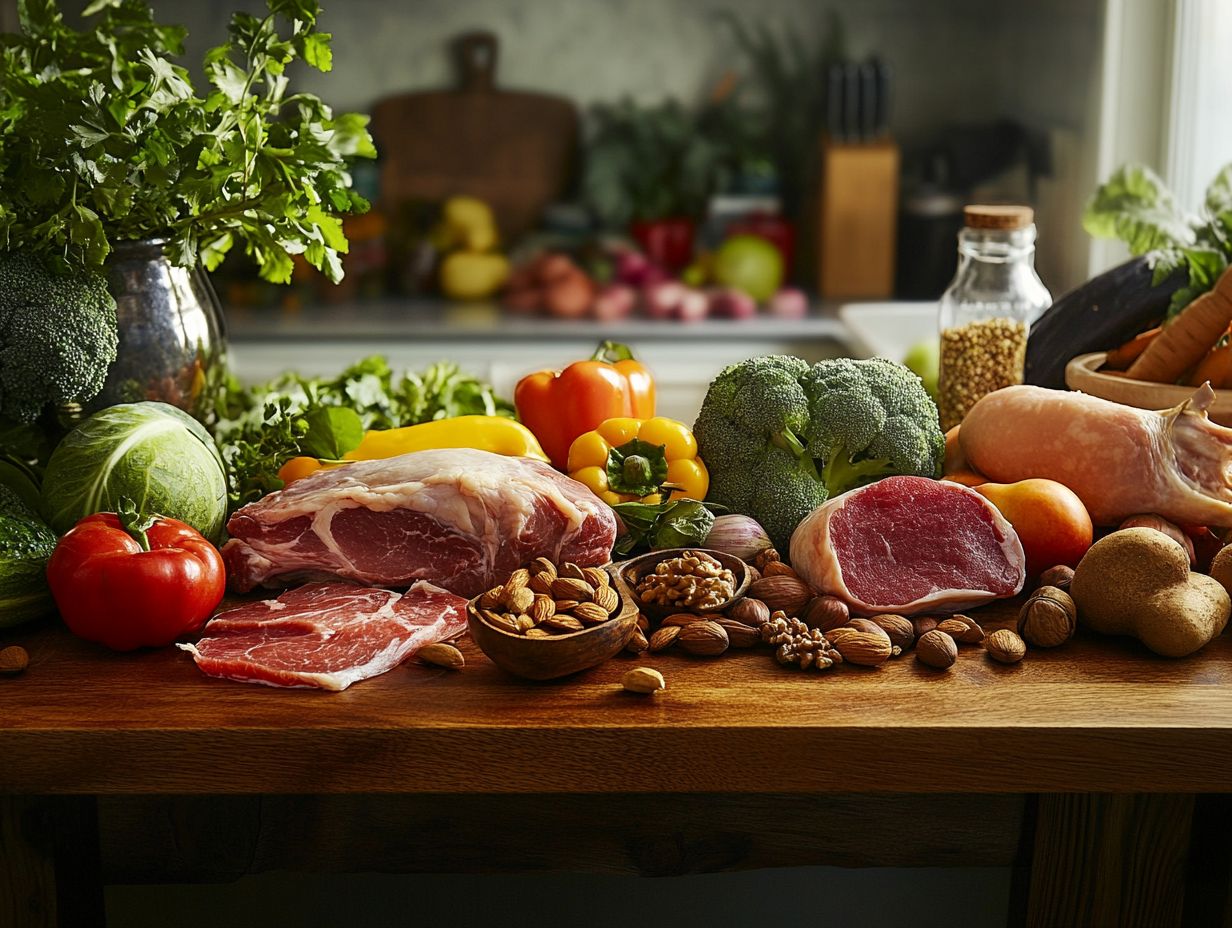
Addressing concerns about the Paleo diet starts with recognizing the importance of dietary balance and ensuring that your nutritional needs are met. This understanding helps you integrate practical strategies to manage any potential risks associated with this approach.
Focus on a variety of foods, such as fruits, vegetables, lean meats, fish, and nuts, to achieve the nutrients you need. Including diverse and colorful produce greatly enhances your fiber intake and boosts antioxidant levels. Selecting high-quality protein sources ensures you receive adequate amino acids for muscle repair and synthesis.
Consider adding more omega-3 fatty acids to your diet by choosing fatty fish, which can help reduce inflammation and promote heart health.
Incorporating Exercise into the Paleo Lifestyle
Exercise is a game-changer for your Paleo lifestyle! It complements your diet perfectly by enhancing physical fitness and facilitating weight loss through effective workouts and meaningful lifestyle changes.
Embracing this synergy empowers you to reach your wellness goals more efficiently. Are you ready to embrace a healthier lifestyle? Start incorporating exercise today for a healthier you!
Effective Workouts for Optimal Health
Integrating effective workouts into your Paleo lifestyle can elevate your physical fitness and overall health. Consider high-intensity interval training, or HIIT, as a standout option. This workout alternates between short bursts of intense exercise and rest, capturing quick and efficient energy bursts that mirror the active lifestyles of our ancestors.
These short, intense sessions rev up your metabolism and enhance your cardiovascular health.
Functional strength exercises, like squats and lunges, reflect everyday movements. They enable you to build strength in a practical way.
Engaging in outdoor activities like hiking through serene landscapes or scaling challenging rock faces deepens your connection with nature and boosts your physical endurance.
Together, these workouts align with the Paleo philosophy, fostering a holistic approach to well-being that resonates with natural human movement and nutritional fundamentals.
Preguntas Frecuentes
Qu es la Dieta Paleo y c mo funciona?
La Dieta Paleo, tambi n conocida como la Dieta del Hombre de las Cavernas, es un enfoque diet tico que se centra en comer alimentos enteros y no procesados. Estos alimentos estaban disponibles para nuestros ancestros durante la era Paleol tica, e incluyen carnes magras, pescado, frutas, verduras, nueces y semillas. La dieta evita granos, productos l cteos y alimentos procesados. La idea es imitar los h bitos alimenticios de nuestros ancestros para optimizar nuestra salud y prevenir problemas modernos como la obesidad y enfermedades cr nicas.
Es la Dieta Paleo adecuada para todos?

La Dieta Paleo generalmente se considera segura y adecuada para la mayor a de las personas. Sin embargo, siempre es mejor consultar con un profesional de la salud antes de empezar cualquier nueva dieta, especialmente si tienes condiciones de salud preexistentes o alergias. Adem s, las mujeres embarazadas o lactantes, los ni os y las personas con ciertas condiciones m dicas pueden necesitar modificar la dieta.
Puedo perder peso con la Dieta Paleo?
Muchos han reportado xito en la p rdida de peso con la Dieta Paleo, pero no est garantizado. La dieta enfatiza alimentos enteros y densos en nutrientes, limitando los procesados y altos en calor as, lo que puede ayudar en la p rdida de peso. Sin embargo, los resultados var an seg n la composici n corporal espec fica, el nivel de actividad y la adherencia a la dieta.
Es caro seguir la Dieta Paleo?
La Dieta Paleo puede ser m s cara que una dieta occidental t pica, pero no tiene que serlo. Puedes ahorrar dinero comprando productos de temporada, comprando carnes al por mayor y eligiendo frutas y verduras congeladas o enlatadas. Tambi n es crucial planificar tus comidas y seguir una lista de compras para evitar gastos innecesarios. A largo plazo, una dieta saludable puede ayudarte a ahorrar en gastos m dicos.
Cu les son algunos beneficios potenciales de seguir la Dieta Paleo?
Los beneficios de la Dieta Paleo pueden incluir p rdida de peso, mejor control del az car en sangre, aumento de energ a, mejor digesti n y reducci n de la inflamaci n. Dado que se compone principalmente de alimentos no procesados, tambi n puede mejorar la ingesta de nutrientes y promover un microbioma intestinal saludable. Sin embargo, se necesita m s investigaci n para entender completamente sus beneficios y riesgos potenciales.
Todav a puedo disfrutar de golosinas y postres en la Dieta Paleo?
La Dieta Paleo fomenta un enfoque en alimentos densos en nutrientes, pero eso no significa que no puedas disfrutar de golosinas y postres con moderaci n. Existen muchas recetas amigables con Paleo para postres que utilizan ingredientes naturales como frutas, nueces y edulcorantes naturales como miel o jarabe de arce. Recuerda que estos tambi n deben consumirse con moderaci n para mantener una dieta equilibrada.
